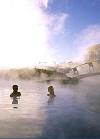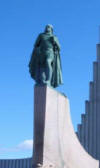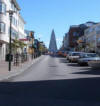

CAUSE 2003 Home Previous Dispatch Dispatch Home Next Dispatch
The New Gold Rush
Day 1: Keflavik, Njardvik, Svarstsengi, and Reykjavik
by Katie Strass
Góđan dag! Welcome to Iceland. It is currently seven o’clock in the morning, Icelandic time. I hope you are well rested after your red-eye flight from Baltimore to Kelfavik International Airport because we have a full day of activities planned. First, we’ll take a quick stop at the hostel in Njardvik where we’ll be staying.
Our drive from Kelfavik to Njardvik takes us southeast down route 41. Njardvik (population 2,500) is located right on the coast and is known for fishing and its proximity to the Blue Lagoon. On our way to the hostel we get our first real glimpse of the Icelandic landscape. I’m reminded of pictures I’ve seen of Mars, an uninviting landscape with very little flora or fauna. It is not until we get closer to our hostel in Njardvik and the shore that I see any seabirds. Although it is mid-May, the cold wind demands a winter coat and hat and gloves for those who thought to bring them. After dropping our luggage off at the hostel, we take a quick drive downtown and eat breakfast at the only place open, a quaint little bakery. We overrun the small shop, filling all the tables while we watch local fisherman come in to get their morning coffee before heading out to their boats. Most are wearing thick overalls and are sporting fair skin and light hair stereotypical of Viking descendants.
Our first tour of the day is at the Svarstengi Geo-thermal plant. It is only a fifteen minute drive south on route 43 from our Hostel, which was nonetheless quite an adventure for those of us in Derek’s van.
Upon arriving at Svarstengi, we received a lecture explaining how the geothermal plant operates.
Iceland is located on top of a Hot Spot. A Hot Spot is an area in the earth’s crust where there is a great upsurge of magma; increasing the amount of volcanism in the region independent of tectonic plate boundaries. What this means to Svarstengi is that they can drill boreholes less than one kilometer into the ground and reach geothermal fluids at temperatures greater than 200°C. The plant pumps the hot seawater out of the ground and utilizes heat exchangers to heat cool groundwater that is sent to local communities on the Reykjanes peninsula to be used as district heating.
Steam from the boreholes is also used at the plant in generators to produce electricity. Svarstengi extracts 6-7 tonnes/year of steam and water from the reservoir. Before reinjection, the geothermal fluid must be mixed with condensate steam to decrease the silica concentration and increase the pH, this is necessary to prevent scaling and clogging. 85 percent of the homes in Iceland are heated by geothermal water making Icelanders the greatest users of geothermal energy per capita in the world, a whopping 24,000 kWh per capita.
After the brief lecture, we receive a tour of the plant and Gja´in, a small museum located in the basement of the welcome center, which utilizes visuals and sound to demonstrate the workings of Iceland’s geology and geothermal activity.
 picture courtesy of Eric
Chastain. One of the most interesting aspects of
Svarstengi is that its effluent wastewater is
reused in a resort spa downstream. The Blue Lagoon was created when the power
plant made the mistake of trying to reinsert its used streams into the ground
by spreading it over an area and letting it permeate into the ground
naturally, thus cleaning it and warming it for reuse by the plant. However
Svarstengi miscalculated and instead of draining
into the ground, the effluent water pooled. The residents of the area did not
fail to notice the unnaturally blue lake that formed near the power plant.
The bolder of the curious decided to check it out for themselves. After
bathing in the warm blue lake for a couple days the Icelanders noticed that
the water had curing properties. Today, Svarstengi
reinserts its effluent streams using reinjection
wells, releasing only enough wastewater downstream to maintain the level of
the artificial lake, now named the Blue Lagoon, one of Iceland’s most popular
tourist locations.
picture courtesy of Eric
Chastain. One of the most interesting aspects of
Svarstengi is that its effluent wastewater is
reused in a resort spa downstream. The Blue Lagoon was created when the power
plant made the mistake of trying to reinsert its used streams into the ground
by spreading it over an area and letting it permeate into the ground
naturally, thus cleaning it and warming it for reuse by the plant. However
Svarstengi miscalculated and instead of draining
into the ground, the effluent water pooled. The residents of the area did not
fail to notice the unnaturally blue lake that formed near the power plant.
The bolder of the curious decided to check it out for themselves. After
bathing in the warm blue lake for a couple days the Icelanders noticed that
the water had curing properties. Today, Svarstengi
reinserts its effluent streams using reinjection
wells, releasing only enough wastewater downstream to maintain the level of
the artificial lake, now named the Blue Lagoon, one of Iceland’s most popular
tourist locations.
 From Svarstengi we head north
to the capitol city of Reykjavík. With a population of just over 100,000,
Reykjavík feels more like a large town than a city. The streets are lined
with brightly painted homes and shops usually no more than four stories high.
We park the vans next to the impressive Hallgrimskirkja
church and the magnificent statue of Leifur
Eiriksson looking boldly down over the city and
out to the sea. We first head downtown to grab some lunch and then begin
collecting information for our research topics.
From Svarstengi we head north
to the capitol city of Reykjavík. With a population of just over 100,000,
Reykjavík feels more like a large town than a city. The streets are lined
with brightly painted homes and shops usually no more than four stories high.
We park the vans next to the impressive Hallgrimskirkja
church and the magnificent statue of Leifur
Eiriksson looking boldly down over the city and
out to the sea. We first head downtown to grab some lunch and then begin
collecting information for our research topics.

 pictures courtesy of Eric
Chastain. Team Daedalian, whose project
involved an in depth study of Iceland’s energy policies, heads for the
Ministry of Energy and the Ministry for the Environment. The government
officials at each office are extremely helpful providing copies of Iceland’s
National Strategy for Sustainable Development and Iceland’s National
Programme of Action. We discovered that many of
the locals, even those working in the Ministry for the Environment have little
interest in the Hydrogen pumping Station inaugurated the 24th of
April 2003, the first in the world! Although the Icelandic government is
striving to become the first fossil fuel independent country by 2030, we find
that many of its people have little interest or knowledge of this lofty goal.
pictures courtesy of Eric
Chastain. Team Daedalian, whose project
involved an in depth study of Iceland’s energy policies, heads for the
Ministry of Energy and the Ministry for the Environment. The government
officials at each office are extremely helpful providing copies of Iceland’s
National Strategy for Sustainable Development and Iceland’s National
Programme of Action. We discovered that many of
the locals, even those working in the Ministry for the Environment have little
interest in the Hydrogen pumping Station inaugurated the 24th of
April 2003, the first in the world! Although the Icelandic government is
striving to become the first fossil fuel independent country by 2030, we find
that many of its people have little interest or knowledge of this lofty goal.
On the way out of the city we take a detour to see the fueling station for ourselves. It is impressive with “Shell Hydrogen Fueling Station” painted in large blue letters on the side. However, upon asking one of the gas station attendants what he thinks about the addition of hydrogen to the station he shrugs and says he doesn’t really know that much about it, but thinks a bit of a waste as there is only one car in the entire city that can use it. It’s an honest, if not slightly depressing comment to those of us fascinated by the idea of a clean energy society. The station is utilizing electrolysis technology to produce hydrogen from water using electricity generated from renewable energy. Three hydrogen powered city buses, scheduled to come online in the near future, will use this station as their fueling point. The government is hoping this will be the first step to moving Iceland toward a hydrogen economy. Pending the success of these first three buses, the government will replace a larger portion of its fleet with hydrogen powered buses and introduce privately owned hydrogen powered vehicles, marine vessels, and fishing boats.
 picture
courtesy of Jen Holzhauser. Upon departing Reykjavík, we head for the Blue Lagoon for
a bit of relaxation and pampering. The lagoon is set among volcanic rocks,
making the whole experience a bit other-worldly. The whole place looks like
something you’d see in a SciFi movie and you’re
playing the role of the Martian settler.
picture
courtesy of Jen Holzhauser. Upon departing Reykjavík, we head for the Blue Lagoon for
a bit of relaxation and pampering. The lagoon is set among volcanic rocks,
making the whole experience a bit other-worldly. The whole place looks like
something you’d see in a SciFi movie and you’re
playing the role of the Martian settler.
We rap the day up in true Penn State fashion with a trip to the local pub. The only people there are a couple of U.S. sailors from the nearby Navy base and a few locals; most won’t be out until later in the night. We leave at midnight and the sky is still holding onto dusk. Although we’ve been going nonstop since yesterday (and it seems much longer than that), I don’t know how I’m going to sleep with it still being light out. But not to worry; as soon as my head hits the pillow I’m going to be out like a light, and all too soon Derek will be knocking on my door announcing it’s time to get up.
 picture courtesy of Eric Chastain.
picture courtesy of Eric Chastain.
Góđa nótt, good night and sweet dream!
Katie Strass is a Graduate in Environmental Systems Engineering.
CAUSE 2003 Home Previous Dispatch Dispatch Home Next Dispatch
Last updated: Wednesday December 03, 2003